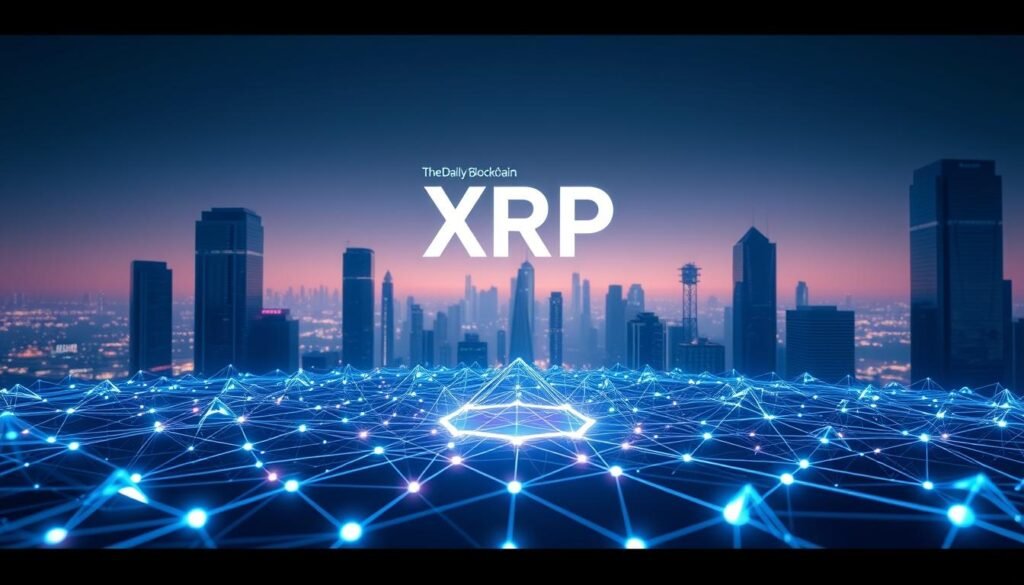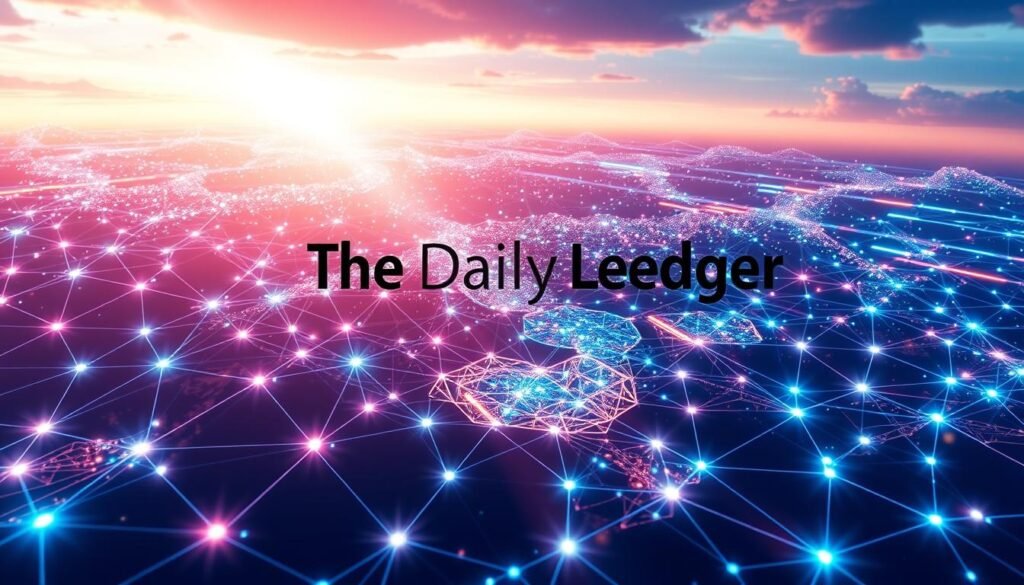Surprising fact: the XRP Ledger reaches consensus every 3–5 seconds, making settlement speeds rival traditional rails while using energy like an email server.
This mature public network was built in 2012 and focuses on speed, low fees, and interoperability for global payment and settlement use cases.
The native asset powers transactions and keeps spam low with tiny, predictable fees. The base layer supports token issuance, a built-in decentralized exchange, and escrow features that help move value and tokens at scale.
Why it matters: crypto users and financial institutions look to this ledger for cross-border payments, tokenized assets, and exchange functionality in a single system. Open-source code and a public validator community add transparency and long-term information confidence.
This introduction previews a comparison of performance, tokenomics, security, regulation, and adoption to help readers judge market fit for banks, enterprises, and remittance flows.
Key Takeaways
- The xrp blockchain offers near-instant settlement with low, predictable fees.
- The xrp ledger supports token issuance, DEX features, and escrow on the base layer.
- Its design favors real-world use: cross-border payments and fiat bridging.
- Open-source code and validators provide transparency and community trust.
- Pre-mined token supply gives predictable issuance compared with many crypto assets.
What the XRP Ledger is and why it matters today
Designed for real payments, the ledger is a public, permissionless system optimized for rapid settlement and steady performance.
Validators maintain consensus via a Unique Node List (UNL), finalizing transactions in about 3–5 seconds. That approach avoids energy-intensive mining and provides deterministic finality for time-sensitive payment flows.
The network uses a small-world topology, which helps information spread quickly between nodes. This efficient design keeps energy use low and supports reliable data propagation across a mature network.
“Fast confirmation and predictable fees make the ledger attractive for institutions and developers.”
- Token basics: 100 billion pre-mined, with a large share given to Ripple Labs and substantial amounts held in escrow. A noted portion — described as billion xrp in escrow — shapes circulating supply.
- Why it matters: stability, low fees, built-in escrow and native token features reduce operational risk for financial institutions and payment providers.
- Regulatory clarity: the July 2023 U.S. ruling that the token is not inherently a security changed compliance dynamics for companies building on the ledger.
Together, these traits speed cross-border payments, improve fiat-bridging UX, and give enterprises clearer security and data transparency for mission-critical systems.
Consensus compared: XRP Ledger vs Proof-of-Work, Proof-of-Stake, and Solana’s hybrid
How a ledger reaches agreement shapes finality, throughput, and the safety of value transfers.
UNL-based consensus and rapid finality
The XRPL uses a federated Unique Node List where trusted validators exchange proposals and vote. Ledgers typically finalize in about 3–5 seconds with an ~80% agreement threshold, giving deterministic ordering and quick protection against double-spend.
Proof-of-Work, Proof-of-Stake, and Solana’s mix
- PoW (Bitcoin): high energy, slower confirmations due to mining difficulty.
- PoS (Ethereum): far lower electricity use but depends on staked capital and validator incentives.
- PoH/PoS (Solana): timestamps plus staking for very high throughput, trading complexity for speed.
Trust, decentralization, and real-world trade-offs
Debates center on UNL selection and validator diversity. More varied lists improve perceived security, while curated lists favor performance and predictable uptime.
Consensus mechanics materially affect security, uptime, and user trust across crypto systems.
Throughput, settlement time, and fees: where xrp blockchain stands out
Built to move value quickly, the system supports real-time settlement for commerce and services. That design makes it a practical choice for use cases that need predictable timing and low operational cost.
Transactions per second and finality
Raw throughput: the ledger handles about 1,500 transactions per second, which enables high-frequency settlement and machine-to-machine commerce.
Finality is typically reached in ~4 seconds, a huge improvement over Bitcoin (minutes) and Ethereum (tens of seconds to minutes). These metrics matter because they directly affect user experience and time-to-value when settling payments or exchanging assets.
Cost efficiency and fee mechanics
Network fees are tiny—often fractions of a cent—and dynamically adjust to deter spam while keeping costs stable for real workloads.
- Fee-burn mechanics slowly reduce supply; in December 2024 about 4,500 XRP were burned daily as operational data shows.
- Predictable performance supports payments, asset exchange, and automated settlement at scale.
- Validator performance and network conditions map TPS figures to real-world capacity for enterprises.
Data-backed benchmarks like TPS and seconds to finality are essential when deciding if a system can handle production workloads.
Tokenomics in comparison: 100 billion pre-mined XRP vs mined or staked issuance
Supply design shapes long-term value: a fixed 100 billion stock issued in 2012 contrasts with assets that mint new units via mining or staking.
Distribution snapshot: all 100 billion tokens were created at genesis. About 80% was allocated to ripple labs, and 55 billion was placed into escrow in 2017 with 1 billion unlocking each month.

Escrow mechanics and current status
Each month 1 billion unlocks for potential sale or release. Unsold portions are typically re-locked, creating a controlled cadence.
Net sales have averaged roughly 3–4 billion per year while about 8–9 billion are often re-locked annually. That process leaves approximately 38 billion xrp still in escrow today.
Supply dynamics and fee burns
Transaction fees on the ledger are burned, removing units permanently and nudging supply toward slight deflation as activity rises.
If recent net distribution rates continue, escrow holdings could fall to zero around 2035–2038, which may shift market supply dynamics.
How issuance compares across major assets
Unlike a 100 billion pre-mined model, Bitcoin issues a capped 21 million via PoW mining rewards. Ethereum moved to PoS issuance, and Solana combines PoH with PoS and declining inflation.
Key point: fixed pre-mined supply plus escrow controls give companies and investors more predictable issuance than many mined or staked systems.
| Feature | Pre-mined (100 billion) | PoW / PoS / Hybrid |
|---|---|---|
| Initial supply | 100 billion (all created) | Inflationary reward schedules (mined or staked) |
| Major holder | ~80% allocated to ripple labs, escrowed portions | Distributed among miners/validators and stakers |
| Supply control | Monthly unlocks, re-locks, fee burns | Protocol-defined issuance and halving or staking rates |
| Long-run scarcity | Possible depletion of escrow by 2035–2038 | Depends on emission schedules and burn mechanisms |
Payments and institutions: XRP as a bridge asset vs general-purpose crypto platforms
Banks and payment providers are testing on-demand liquidity to cut funding friction for cross-border flows.
On-demand liquidity for cross-border payments
On-Demand Liquidity (ODL) uses a bridge asset to enable instant FX conversion. That reduces or removes the need for pre-funded nostro accounts and lowers working capital for banks and remitters.
RippleNet rails and integration
RippleNet offers xCurrent for real-time messaging, xRapid for liquidity on demand using a bridge token, and xVia for standardized API integration.
These rails plug into existing payment stacks and help deliver predictable, near-instant settlement for corridors that need speed and low cost.
Enterprise adoption and central bank pilots
Financial institutions like American Express (with Santander), Banco Rendimento, and Bitso have trialed ODL to improve remittances.
Bank of America has explored DLT-based settlement, while central banks — including Bhutan’s RMA, SAMA, and the Bank of Thailand — have run pilots for cross-border use cases.
Stable value flows and tokenized Treasuries
RLUSD is a 1:1 U.S. dollar-backed stablecoin that eases corridor liquidity. Paired with tokenized U.S. Treasuries (OUSG) via a Ripple–Ondo partnership, institutions can settle 24/7 with institutional-grade assets.
“Using a bridge asset can dramatically shorten settlement chains and free capital for productive use.”
| Feature | Payments-first rails | General-purpose platforms |
|---|---|---|
| Primary focus | Real-time payments and liquidity | dApps, smart contracts, broad token use |
| Integration | APIs for banks; plugins to core systems | SDKs and developer ecosystems |
| Institutional examples | American Express, Banco Rendimento, Bitso | Exchanges and DeFi platforms |
| Liquidity tooling | Stablecoins (RLUSD), tokenized Treasuries (OUSG) | On-chain liquidity pools and AMMs |
Security, stability, and regulation: understanding risk and resilience
Real-world security for payment rails requires both diverse validators and clear legal signals. This section explains how topology, governance, and market behavior shape operational risk for banks and regulators.

Network shape and validator configuration
The peer-to-peer overlay shows a small-world topology with tight clusters and short node paths. That design helps information propagate fast and reduces latency across the network.
Validator diversity and UNL configuration matter. A varied set of trusted nodes improves resilience, while curated lists favor predictable uptime for mission-critical systems.
Legal clarity and enforcement
In July 2023 a U.S. court held that the token itself is not a security, though some token sales can qualify as securities offerings. This ruling gave firms clearer compliance paths and reduced legal uncertainty for institutional pilots.
Market behavior, correlations, and monitoring
Correlation studies show the token often tracks less closely with BTC, ETH, and SOL than those assets do with each other. Relationships to the u.s. dollar and equity indices vary over time.
“Data-driven monitoring of uptime, finality, and throughput is essential for operational risk management.”
Transparent information and tooling let financial institutions watch finality, consensus thresholds, and throughput. That visibility supports SLAs and governance needs.
| Risk area | What matters | Practical effect |
|---|---|---|
| Topology | Small-world overlay, short paths | Faster propagation, lower latency |
| Governance | UNL setup, validator mix | Balance of security and uptime |
| Regulation | 2023 U.S. ruling, evolving policy | Improved compliance clarity for banks |
| Market risk | Asset correlations to BTC/ETH/SOL and USD | Portfolio diversification and hedging needs |
Stability notes: deterministic finality and a high consensus threshold reduce forks and rollbacks. Ongoing policy moves — including discussions of a possible digital asset stockpile in 2025 — form the regulatory backdrop institutions watch closely.
For banks and financial institutions, these elements converge into requirements for strong governance, clear compliance pathways, and predictable performance before production deployments.
When to choose XRPL over other cryptocurrencies for real-world use cases
Operational payments use cases favor systems designed around rapid finality and steady fees. For teams deciding between platforms, pick the ledger that matches your core needs: speed, cost, and predictable settlement.
Cross-border settlement, tokenized assets, and low-cost transactions
Choose this platform when low fees and fast finality matter. The network offers ~1,500 TPS and ~3–5 second finality, which improves remittance and treasury workflows.
Native tokenization and a built-in exchange simplify issuance, trading, and custody for tokens and assets. Escrow features add controllable settlement flows for institutional use.
- Recommend for cross-border payments where near-zero fees lower working capital needs.
- Ideal for issuing tokens and moving them on-ledger using the native DEX for liquidity.
- Use xrp also as a bridge currency on corridors with limited fiat depth.
- Fit for banks and enterprises that want predictable payment performance without heavy smart-contract overhead on the base layer.
- For EVM-style workloads, deploy sidechains while keeping the base layer focused on security and stability.
Build vs. buy guidance: teams that need fast time-to-production benefit from existing integrations and RippleNet rails. If deep programmability is the priority, opt for general-purpose platforms or sidechains and connect them to this payments-focused system.
Conclusion
To conclude, the xrp ledger delivers predictable finality, low fees, and production-grade throughput for payment rails.
The system settles in about 3–5 seconds and supports roughly 1,500 TPS with fee-burn mechanics, escrow, and a native DEX. Those features support fast value transfer, tokenized assets, and reliable bridge liquidity for real-world payments.
Compared with PoW or PoS systems, this network favors cost efficiency and deterministic settlement while trading some programmability. Open-source code, published metrics, and transparent tokenomics help market participants and investors assess performance.
Use these data points and business requirements—latency, cost, compliance—to align your choice with expected growth and operational outcomes.
FAQ
What is the XRP Ledger and why does it matter today?
The XRP Ledger is a distributed payment ledger designed for fast, low-cost value transfers. It supports native digital assets, token issuance, and real-world payment flows. Financial institutions and payment providers value it for quick settlement, predictable fees, and tools for issuing tokens and stablecoins that integrate with existing rails.
How does the Ledger reach consensus in about 3–5 seconds?
Consensus is reached through a validator agreement process that uses trusted node lists to finalize transactions quickly. Nodes propose and vote on transaction sets; once agreement crosses a threshold, the ledger closes and settlement finalizes in roughly 3–5 seconds, offering deterministic finality without lengthy confirmations.
How does this consensus model compare to Proof-of-Work and Proof-of-Stake systems?
Unlike energy-intensive mining or stake-weighted block proposals, this model relies on validator agreement and selected trusted lists. It reduces latency and energy use while trading some design choices around how validators are selected and trusted. The result is faster finality and lower operational cost compared with PoW and some PoS implementations.
What are Unique Node Lists and why do they matter for decentralization?
Unique Node Lists (UNLs) are curated sets of validators that a participant trusts. They help prevent forks and speed consensus. The degree of decentralization depends on how many independent validators appear across UNLs. Wider validator diversity increases resilience and reduces centralized control risks.
How energy-efficient is this network compared with Bitcoin mining?
The network runs on ordinary servers and has an energy profile closer to email or web services, not the high-power mining farms used by Proof-of-Work systems. This makes it far less carbon-intensive while maintaining high throughput and low-latency settlement.
What throughput and settlement times can users expect?
The ledger can handle approximately 1,500 transactions per second in typical conditions, with finality in about four seconds. That throughput and speed enable rapid cross-border and micropayment use cases compared with many legacy and some crypto networks.
How affordable are transaction fees on the ledger?
Fees are deliberately small, designed primarily to deter spam rather than to compensate validators. Typical costs are near-zero for routine transfers, making microtransactions and high-volume settlement practical for businesses.
How is the token supply structured compared with mined or staked currencies?
The total supply was created at genesis rather than mined over time. A large portion is held in escrow with scheduled unlocks, allowing predictable issuance control. This contrasts with capped mining models or inflationary staking issuance seen in other networks.
What are escrow mechanics and how do they affect supply?
Escrowed holdings are released on a set monthly schedule; unused amounts can be re-escrowed. This mechanism creates predictable, time-bound unlocks and helps manage circulating supply, which can influence long-term scarcity and market dynamics.
How do fee burns and supply dynamics influence long-run scarcity?
Small transaction fees are destroyed rather than redistributed, slowly reducing total supply. Over long periods and with high usage, burned fees could create deflationary pressure, though the effect depends on transaction volume and escrow policy changes.
How do issuance and caps differ from Bitcoin and Ethereum models?
Bitcoin has a capped mined supply with halving events; Ethereum shifted to a fee-burn and staking issuance model after its upgrade. The Ledger’s pre-issued supply and escrowed release offer a different balance between predictability and potential scarcity compared with mined or staked issuance.
What role does the ledger play in payments for banks and payment providers?
It serves as a rails layer for on-demand liquidity and rapid settlement. Institutions can use it as a bridge asset to source liquidity across fiat corridors, reducing the need to pre-fund accounts and speeding cross-border flows.
What enterprise rails and integrations exist for payment providers?
Integration tools and enterprise rails enable messaging, liquidity sourcing, and settlement. These systems connect legacy banking infrastructure with tokenized assets and payment rails, helping banks and providers adopt faster cross-border processes.
Are there examples of central banks or pilots using the ledger?
Several central banks and fintech firms have explored pilots for tokenized assets, payment corridors, and stablecoins on the ledger. These efforts assess interoperability, regulatory compliance, and operational fit with existing systems.
How does the ledger support tokenized stable value flows?
The ledger supports issued tokens, trust lines, and decentralized order books, enabling stablecoins and tokenized Treasuries to move with low friction. This capability supports use cases like tokenized USD and institutional liquidity management.
What are the network’s security and stability features?
Security rests on validator agreement, network topology, and diversity of operators. Small-world network properties and validator diversity help maintain resilience against targeted failures, while ongoing monitoring and upgrades strengthen stability.
What was the regulatory outcome in the U.S. regarding the token’s status?
A 2023 U.S. court ruling clarified aspects of how the token was classified for certain sales and institutional offerings. Regulatory interpretations continue to evolve, and institutions assess compliance based on jurisdictional guidance.
How does market behavior of the token correlate with other assets?
Market movements can correlate with major cryptocurrencies and equities during broader risk-on or risk-off periods, but correlations vary by time frame and macro conditions. Liquidity, adoption news, and macro factors all influence market behavior.
When should developers or institutions choose this ledger over other networks?
Choose it for fast cross-border settlement, tokenized assets, and low-cost high-volume transfers. It fits use cases where deterministic finality, low latency, and cost efficiency matter more than maximal decentralization or smart-contract complexity.
What real-world uses are best suited to this ledger?
Ideal applications include on-demand liquidity for payments, tokenized fiat and securities, micropayments, and enterprise settlement systems that require predictable finality and minimal fees.



